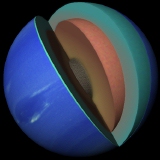 |
|||
|
Neptune's
more varied atmosphere may represent a more dynamic interior.
|
|||
| THE INTERIOR OF NEPTUNE | |||
| Neptune is the smallest and the densest of the gas giants. Its high density (1640 kg m-3) indicates that it contains a greater proportion of heavy elements than the other gas giants. Neptune probably comprises ice and rock, rather like Saturn's moon Titan, with about 15% hydrogen (H2) and a small amount of helium (He). | |||
| The actual structure or layout of Neptune's interior is poorly understood. Some scientists think that beneath its atmosphere, Neptune is a homogenous mixture of icy methane (CH4), ammonia (NH3) , water (H2O)and rock. This seems likely because it takes longer for Neptune to rotate than it would if the planet was "centrally condensed" and had more of its mass focussed at its centre. Even so, it may have a small rocky inner core. Such a core is probably smaller than the Earth, but has about the same mass. | |||
 Cross-section of Neptune. |
|||
| As Neptune does not have a thick and cold gaseous outer layer that helps to keep heat in like Uranus does, heat from its interior can escape quite readily. Neptune is one of the coldest bodies in the Solar System, orbiting the Sun at an average distance of 4,500 million kilometres. | |||
| Neptune formed in part of the Solar System where methane and light elements were more abundant. These ices condensed about rocky nuclei, forming comets and icy asteroids like 2060 Chiron. Bodies with Neptune-crossing orbits, known collectively as Centaurs, were probably far more common during the early history of the Solar System. The Centaurs probably added a great deal of material, rock as well as ice, to the growing Neptune. | |||
|
|
|||